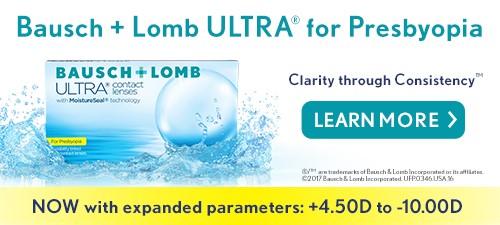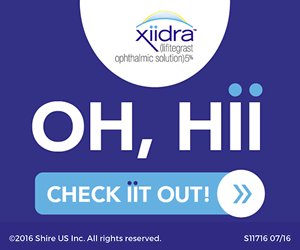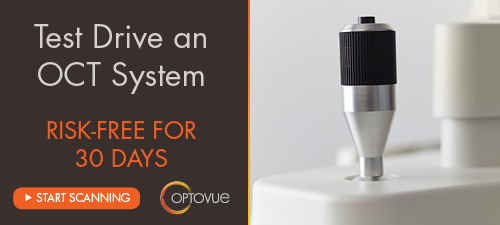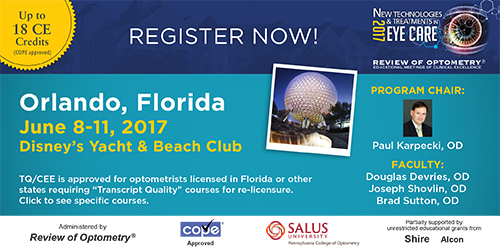
A
weekly e-journal by Art Epstein, OD, FAAO
Off the Cuff: The Devils In The Details – DEWS-II Is Here
The long-awaited DEWS-II report was presented yesterday during a special session of the Association for Research in Vision and Ophthalmology annual meeting in Baltimore. Under the umbrella of the Tear Film and Ocular Surface Society, DEWS-II represents over two years of intense effort by more than 150 clinicians and scientists from around the world. Driven by the passion and dedication of workshop organizer Dr. David Sullivan and his family, the DEWS-II report serves as both an update and an essential consensus document.
|
|||||
|
|||
| Corneal Staining and Hot Black Tea Compresses | ||||
Warm compresses are widely touted as an effective treatment for ocular surface disorders. Black tea compresses are a common household remedy, although there is no evidence in the medical literature proving their effect, and their use may lead to harmful side effects. This article describes a case in which the application of black tea to an eye with a corneal epithelial defect led to anterior stromal discoloration, evaluates the prevalence of hot tea compress use and analyzes, in vitro, the discoloring effect of tea compresses on a model of a porcine eye. Researchers assessed the prevalence of hot tea compresses in the local community and explored the effect of warm tea compresses on the cornea when the corneal epithelium's integrity was disrupted. An in vitro experiment in which warm compresses were applied to 18 fresh porcine eyes was performed. In half the eyes, a corneal epithelial defect was created, and in the other half, the epithelium was intact. Both groups were divided into subgroups of three eyes each and treated experimentally with warm black tea compresses, pure water or chamomile tea compresses. Researchers also performed a study in patients with a history of tea compress use. Brown discoloration of the anterior stroma appeared only in the porcine corneas that had an epithelial defect and were treated with black tea compresses. No other eyes from any group showed discoloration. Of the patients included in the survey, approximately 50% had applied some sort of tea ingredient as a solid compressor or as the hot liquid. Researchers concluded that an intact corneal epithelium served as an effective barrier against tea-stain discoloration; only when this layer was disrupted did the damage occur. Therefore, they wrote, direct application of black tea (Camellia sinensis) to a cornea with an epithelial defect should be avoided. |
||||
SOURCE: Achiron A, Birger Y, Karmona L, et al. Corneal staining and hot black tea compresses. Isr Med Assoc J. 2017;19(3):152-155. |
||||
 |
||
| Traumatic Corneal Flap Displacement After LASIK | ||||
Laser in situ keratomileusis (LASIK) is the most common and popular procedure performed for the correction of refractive errors in the last two decades, investigators wrote. They reported a case of traumatic flap displacement with flap folding that occurred three years after LASIK was performed. Previous literature reports suggested that vision prognosis would be closely related to proper and prompt management of traumatic flap displacement with flap folding three years after LASIK. A 23-year-old woman presented to the investigators’ hospital after having undergone uneventful LASIK in both eyes three years prior. Subsequent to the procedure, she had suffered a blunt trauma in her right eye in a car accident. A late onset of corneal flap displacement was found with upper and lower portion of the flap folded inside the corneal bed. Surgical intervention for debridement with subsequent reposition of corneal flap was performed as soon as possible in the operating room. A bandage contact lens was placed, and topical antibiotic and corticosteroids were given postoperatively. Two days after the operation, the displaced corneal flap was found to be attached smoothly on the corneal bed without folds. The best-corrected visual acuity was 6/6 with refraction of -0.75D to 1.0D ×175 degrees in the right eye one month later. Investigators reviewed a total of 19 published cases of late-onset traumatic flap dislocations or displacements after LASIK, with complete data from 2000 to 2014. They determined that traumatic displacement of corneal flaps after LASIK could occur after blunt injury with specific direction of force to the flap margin, especially tangential one. According to previous literature reports, late-onset traumatic flap displacement could happen at any time after LASIK and be caused by various types of injuries. Good visual function was primarily restored with immediate and proper management. |
||||
SOURCE: Tsai TH, Peng KL, Lin CJ. Traumatic corneal flap displacement after laser in situ keratomileusis (LASIK). Int Med Case Rep J. 2017;10:143-8. |
||||
 |
||
| No Differences in Central Corneal Thickness Between Open-angle and Pseudoexfoliation Glaucoma Patients | ||||
Measurements of intraocular pressure (IOP) with Goldmann applanation tonometry are affected by central corneal thickness (CCT), as thinner corneas underestimate and thicker corneas overestimate the true IOP value, researchers wrote. The literature is controversial regarding CCT values in patients with primary open-angle glaucoma (POAG) and exfoliation glaucoma (XFG), they added. The aim of this study was to evaluate CCT in patients with XFG and POAG. CCT was evaluated with optical coherence tomography (OCT). All participants who were previously diagnosed with either POAG or XFG underwent ophthalmological examinations. Contact lens users and patients with corneal diseases were excluded. A total of 145 patients were enrolled in this study. The mean CCT was 535µm ± 30.4µm in patients with POAG and 536µm ± 33.7µm in patients with XFG. The result was not statistically significant (p=0.98). The mean age for all participants was 73.8 years ± 7.7 years. The study included totally 61 women and 84 men. The two groups were similar in their demographic data, and mean deviation was the only parameter that differed statistically when comparing POAG with XFG (p=0.02). The findings indicated that patients with XFG did not have thinner corneas than those with POAG; as such, CCT could not explain why they progressed differently. |
||||
SOURCE: Ayala M, Karlsson J. No differences in central corneal thickness between open-angle and pseudoexfoliation glaucoma patients. Clin Ophthalmol. 2017;11:733-738. |
||||
|
|||
| News & Notes | |||||||||
| Shire & Parion Sciences Enter Into Collaborative License Agreement A new Shire and Parion Sciences agreement grants Shire exclusive worldwide rights to develop and commercialize P-321, an investigational epithelial sodium channel inhibitor for the potential treatment of dry-eye disease in adults, with the opportunity for Parion to co-fund activities. P-321 is a Phase II compound being developed to address tear volume deficiency and promote ocular surface healing. While further clinical trials are needed to fully evaluate its safety profile and efficacy, P-321 is a novel molecule believed to inhibit ENaC, which is thought to block the absorption of tears and help keep the ocular surface hydrated. While terms of the deal were not disclosed, Shire will make an initial $20 million upfront license payment with an additional $20 million payment based on the achievement of a near-term development milestone. Read more. |
|||||||||
| TearScience Introduces LipiFlow Activator II, Discusses How LipiFlow Treatment Aids MGD & Presumed Sjögren’s Syndrome TearScience released the LipiFlow Activator II device, built for the same level of quality and efficacy as the original Activator and consisting of a scleral lens heating surface, shield structure and pulsation bladders that directly interface with the patient oculus. The Activator II, which meets the same standard for sterility as its predecessor, is compatible with existing LipiFlow systems and used with a separate, semi-permanent cable that remains connected to the LipiFlow Console. The LipiFlow System now includes a reusable cable to reduce waste. Read more. In addition, TearScience discussed the successful results of a physician-sponsored study demonstrating that a single treatment using the LipiFlow thermal pulsation system effectively improved signs and symptoms of dry eye in individuals with meibomian gland dysfunction who tested positive for biomarkers of Sjögren’s syndrome. (Two of the authors are consultants to TearScience, and one is an employee of the company.) In the retrospective study, titled “Meibomian gland dysfunction patients with novel Sjögren’s syndrome biomarkers benefit significantly from a single vectored thermal pulsation procedure: A retrospective analysis,” investigators reviewed the medical records of 102 eyes of 59 individuals who received a LipiFlow vectored thermal pulsation treatment for verified MGD; 23 of these patients also tested positive for biomarkers associated with Sjögren’s syndrome. Eight weeks after receiving the treatment, scores on the Standard Patient Evaluation of Eye Dryness questionnaire and measurements of tear breakup times improved in all individuals, with no difference based on Sjögren’s syndrome status. Researchers found additional improvements from baseline to week eight in meibomian gland score, although the results were slightly better for individuals who didn’t test positive for Sjögren’s syndrome biomarkers. Read more about the company.
|
|||||||||
| Reliance Introduces Redesigned Premiere Collection Reliance Medical Products launched completely redesigned Premiere Collection 7000 and 710 exam and procedure chairs for eyecare and ENT practices. Available in four new color themes or 16 different customizable color combinations, these chairs are intended to bring modern, stylish design to the exam room. Inspired by the latest trends in retail and spa design, the Premiere Collection’s new color themes—Lucent, Woodland, Harmony and Industrial—were created to complement any contemporary interior aesthetic. These new color options will be on display at booth #2013 at the American Society of Cataract and Refractive Surgery 2017 annual meeting (May 5-9) in Los Angeles. Read more. |
|||||||||
| Alcon Launches Multifocal Toric IOL With Activefocus Optical Design Alcon will introduce its AcrySof IQ ReStor +2.5 Multifocal Toric intraocular lens with Activefocus optical design at the American Society of Cataract and Refractive Surgery 2017 annual meeting (May 5-9) in Los Angeles. The toric IOL recently gained U.S. Food and Drug Administration approval for use in patients undergoing cataract surgery who choose to address their astigmatism and presbyopia at the same time. A live surgery event will give surgeons a front-row view of the new technology and other innovations. Alcon will also host numerous panel discussions and symposia highlighting the Activefocus optical design, celebrating the 50th anniversary of phacoemulsification and introducing the Centurion Vision System with Intrepid Transformer I/A Handpiece, and featuring the recently launched CyPass Micro-Stent for addressing cataracts and glaucoma at once. Read more. |
|||||||||
| Oasis to Debut Punctal Plug & Eyelid Cleansing Solutions OASIS Medical invites eye-care providers to booth #913 at the American Society of Cataract and Refractive Surgery 2017 annual meeting (May 5-9) in Los Angeles to learn more about its new medium term plug for the Soft Plug punctal occlusion line and the addition of Oasis Lid & Lash pre-soaked pads, available with or without tea tree oil, to their daily lid hygiene line of solutions for patients with dry eye. The new Soft Plug Extended Duration 180, a canalicular implantable plug made of an absorbable polydioxanone material, lasts up to 180 days and is available in three sizes: 0.3mm x 2mm; 0.4mm x 2mm; and 0.5mm x 2mm. Read more. |
|||||||||
| Academy 2017 Chicago Scientific Program Calls for Abstracts The Scientific Program Committee of the American Academy of Optometry invites the submission of abstracts for Academy 2017 Chicago (Oct. 11-14) through May 31. This year, the committee will present focused sessions with extended discussions, integration of clinical topics and debates on current controversies. It will consider all presentations, including those from students and residents. Read more. |
|||||||||
Imprimis Launches Combination Glaucoma Drops at ASCRS & Pens Agreement With SightLife for Serum Tears
|
|||||||||
|
Optometric Physician™ (OP) newsletter is owned and published by Dr. Arthur Epstein. It is distributed by the Review Group, a Division of Jobson Medical Information LLC (JMI), 11 Campus Boulevard, Newtown Square, PA 19073. HOW TO ADVERTISE |





